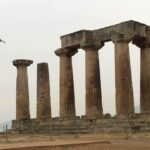THE ANCIENT AGORA OF ATHENS
The Ancient Agora of Classical Athens is the best-known example of an ancient Greek agora, located to the northwest of the Acropolis and bounded on the south by the hill of the Areopagus and on the west by the hill known as the Agoraios Kolonos, also called Market Hill. The Agora’s initial use was for a commercial, assembly, or residential gathering.

The Areopagus sermon refers to a sermon delivered by Apostle Paul in Athens, at the Areopagus, and recounted in Acts 17:16–34. The Areopagus sermon is the most dramatic and fullest reported speech of the missionary career of Saint Paul and followed a shorter address in Lystra recorded in Acts 14:15-17. It is believed that he had preached his sermon at The Agora in Athens.
THE BEMA
The bema, or bima, is an elevated platform used as an orator’s podium in ancient Athens. In Jewish synagogues, it is also known as a bimah and is for Torah reading during services. In an Orthodox Jewish synagogue, a bema is the raised area around the aron kodesh or the sanctuary. In antiquity, it was made of stone, but in modern times, it is usually a rectangular wooden platform approached by steps. In Greek law courts, the two parties to a dispute presented their arguments each from separate bemas.
Jewish synagogues, it is also known as a bimah and is for Torah reading during services. In an Orthodox Jewish synagogue, a bema is the raised area around the aron kodesh or the sanctuary. In antiquity, it was made of stone, but in modern times, it is usually a rectangular wooden platform approached by steps. In Greek law courts, the two parties to a dispute presented their arguments each from separate bemas.
The ceremonial use of a bema carried over from Judaism into early Christian church architecture. It was originally a raised platform with a lectern and seats for the clergy, from which lessons from the Scriptures were read and the sermon was delivered. In Western Christianity, the bema developed over time into the chancel (or presbytery) and the pulpit.
MUSEUM OF THE ANCIENT AGORA
The museum is housed in the Stoa of Attalos, and its exhibits are connected with the Athenian democracy. The collection of the museum includes clay, bronze and glass objects, sculpture s, coins, and inscriptions from the 7th to the 5th century BC, as well as pottery of the Byzantine period and the Turkish occupation. The exhibition within the museum contains a work of art that describes the private and public life in ancient Athens. In 2012, a new sculpture exhibition was added to the museum which includes portraits from Athenian Agora excavation. The new exhibition revolves around portraits of idealized gods, officially honored people of the city, wealthy Roman citizens of the 1st and 2nd century AD, 3rd-century citizens, and finally on work of art from private art schools of late antiquity.
s, coins, and inscriptions from the 7th to the 5th century BC, as well as pottery of the Byzantine period and the Turkish occupation. The exhibition within the museum contains a work of art that describes the private and public life in ancient Athens. In 2012, a new sculpture exhibition was added to the museum which includes portraits from Athenian Agora excavation. The new exhibition revolves around portraits of idealized gods, officially honored people of the city, wealthy Roman citizens of the 1st and 2nd century AD, 3rd-century citizens, and finally on work of art from private art schools of late antiquity.
Greece, October 2019



